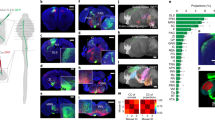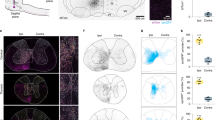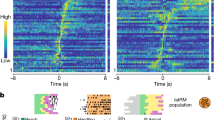Abstract
Proprioceptive sensory signals inform the CNS of the consequences of motor acts, but effective motor planning involves internal neural systems capable of anticipating actual sensory feedback. Just where and how predictive systems exert their influence remains poorly understood. We explored the possibility that spinocerebellar neurons that convey proprioceptive sensory information also integrate information from cortical command systems. Analysis of the circuitry and physiology of identified dorsal spinocerebellar tract neurons in mouse spinal cord revealed distinct populations of Clarke's column neurons that received direct excitatory and/or indirect inhibitory inputs from descending corticospinal axons. The convergence of these descending inhibitory and excitatory inputs to Clarke's column neurons established local spinal circuits with the capacity to mark or modulate incoming proprioceptive input. Together, our genetic, anatomical and physiological results indicate that Clarke's column spinocerebellar neurons nucleate local spinal corollary circuits that are relevant to motor planning and evaluation.
This is a preview of subscription content, access via your institution
Access options
Subscribe to this journal
Receive 12 print issues and online access
$209.00 per year
only $17.42 per issue
Buy this article
- Purchase on Springer Link
- Instant access to full article PDF
Prices may be subject to local taxes which are calculated during checkout







Similar content being viewed by others
References
Eccles, J.C., Oscarsson, O. & Willis, W.D. Synaptic action of group I and II afferent fibres of muscle on the cells of the dorsal spinocerebellar tract. J. Physiol. (Lond.) 158, 517–543 (1961).
Lundberg, A. Ascending spinal hindlimb pathways in the cat. Prog. Brain Res. 12, 135–163 (1964).
Oscarsson, O. Functional organization of the spino- and cuneocerebellar tracts. Physiol. Rev. 45, 495–522 (1965).
Bosco, G. & Poppele, R.E. Proprioception from a spinocerebellar perspective. Physiol. Rev. 81, 539–568 (2001).
Matsushita, M. & Hosoya, Y. Cells of origin of the spinocerebellar tract in the rat, studied with the method of retrograde transport of horseradish peroxidase. Brain Res. 173, 185–200 (1979).
Edgley, S.A. & Jankowska, E. Information processed by dorsal horn spinocerebellar tract neurones in the cat. J. Physiol. (Lond.) 397, 81–97 (1988).
Walmsley, B. Central synaptic transmission: studies at the connection between primary afferent fibres and dorsal spinocerebellar tract (DSCT) neurones in Clarke's column of the spinal cord. Prog. Neurobiol. 36, 391–423 (1991).
Hongo, T. et al. Trajectory of group Ia and Ib fibers from the hind-limb muscles at the L3 and L4 segments of the spinal cord of the cat. J. Comp. Neurol. 262, 159–194 (1987).
Mann, M.D. Clarke's column and the dorsal spinocerebellar tract: a review. Brain Behav. Evol. 7, 34–83 (1973).
Wolpert, D.M., Ghahramani, Z. & Jordan, M.I. An internal model for sensorimotor integration. Science 269, 1880–1882 (1995).
Wolpert, D.M. & Miall, R.C. Forward models for physiological motor control. Neural Netw. 9, 1265–1279 (1996).
Sommer, M.A. & Wurtz, R.H. A pathway in primate brain for internal monitoring of movements. Science 296, 1480–1482 (2002).
Jeannerod, M. Motor Cognition: What Actions Tell the Self 1–21 (Oxford University Press, Oxford, 2006).
Roy, J.E. & Cullen, K.E. Selective processing of vestibular reafference during self-generated head motion. J. Neurosci. 21, 2131–2142 (2001).
Mulliken, G.H., Musallam, S. & Andersen, R.A. Forward estimation of movement state in posterior parietal cortex. Proc. Natl. Acad. Sci. USA 105, 8170–8177 (2008).
Ebner, T.J. & Pasalar, S. Cerebellum predicts the future motor state. Cerebellum 7, 583–588 (2008).
Seki, K., Perlmutter, S.I. & Fetz, E.E. Sensory input to primate spinal cord is presynaptically inhibited during voluntary movement. Nat. Neurosci. 6, 1309–1316 (2003).
Hongo, T. & Okada, Y. Cortically evoked pre- and postsynaptic inhibition of impulse transmission to the dorsal spinocerebellar tract. Exp. Brain Res. 3, 163–177 (1967).
Hongo, T., Okada, Y. & Sato, M. Corticofugal influences on transmission to the dorsal spinocerebellar tract from hindlimb primary afferents. Exp. Brain Res. 3, 135–149 (1967).
Mott, F. Microscopical examination of Clarke's column in man, the monkey and the dog. J. Anat. Physiol. 22, 479–495 (1888).
Nosrat, C.A. et al. Cellular expression of GDNF mRNA suggests multiple functions inside and outside the nervous system. Cell Tissue Res. 286, 191–207 (1996).
Moore, M.W. et al. Renal and neuronal abnormalities in mice lacking GDNF. Nature 382, 76–79 (1996).
Hippenmeyer, S. et al. A developmental switch in the response of DRG neurons to ETS transcription factor signaling. PLoS Biol. 3, e159 (2005).
Matsushita, M. & Gao, X. Projections from the thoracic cord to the cerebellar nuclei in the rat, studied by anterograde axonal tracing. J. Comp. Neurol. 386, 409–421 (1997).
Dumitriu, D., Cossart, R., Huang, J. & Yuste, R. Correlation between axonal morphologies and synaptic input kinetics of interneurons from mouse visual cortex. Cereb. Cortex 17, 81–91 (2007).
Yoshida, Y., Han, B., Mendelsohn, M. & Jessell, T.M. PlexinA1 signaling directs the segregation of proprioceptive sensory axons in the developing spinal cord. Neuron 52, 775–788 (2006).
Alvarez, F.J., Villalba, R.M., Zerda, R. & Schneider, S.P. Vesicular glutamate transporters in the spinal cord, with special reference to sensory primary afferent synapses. J. Comp. Neurol. 472, 257–280 (2004).
Bareyre, F.M., Kerschensteiner, M., Misgeld, T. & Sanes, J.R. Transgenic labeling of the corticospinal tract for monitoring axonal responses to spinal cord injury. Nat. Med. 11, 1355–1360 (2005).
Finger, J.H. et al. The netrin 1 receptors Unc5h3 and Dcc are necessary at multiple choice points for the guidance of corticospinal tract axons. J. Neurosci. 22, 10346–10356 (2002).
López-Bendito, G. et al. Preferential origin and layer destination of GAD65-GFP cortical interneurons. Cereb. Cortex 14, 1122–1133 (2004).
Lomelí, J., Quevedo, J., Linares, P. & Rudomin, P. Local control of information flow in segmental and ascending collaterals of single afferents. Nature 395, 600–604 (1998).
Betley, J.N. et al. Stringent specificity in the construction of a GABAergic presynaptic inhibitory circuit. Cell 139, 161–174 (2009).
Prochazka, A., Gillard, D. & Bennett, D.J. Implications of positive feedback in the control of movement. J. Neurophysiol. 77, 3237–3251 (1997).
Arshavsky, Y.I., Berkinblit, M.B., Fukson, O.I., Gelfand, I.M. & Orlovsky, G.N. Origin of modulation in neurones of the ventral spinocerebellar tract during locomotion. Brain Res. 43, 276–279 (1972).
Arshavsky, Y.I., Gelfand, I.M., Orlovsky, G.N., Pavlova, G.A. & Popova, L.B. Origin of signals conveyed by the ventral spino-cerebellar tract and spino-reticulo-cerebellar pathway. Exp. Brain Res. 54, 426–431 (1984).
Lundberg, A. Function of the ventral spinocerebellar tract. A new hypothesis. Exp. Brain Res. 12, 317–330 (1971).
Poulet, J.F. & Hedwig, B. The cellular basis of a corollary discharge. Science 311, 518–522 (2006).
Blakemore, S.J. & Sirigu, A. Action prediction in the cerebellum and in the parietal lobe. Exp. Brain Res. 153, 239–245 (2003).
Gorski, J.A. et al. Cortical excitatory neurons and glia, but not GABAergic neurons, are produced in the Emx1-expressing lineage. J. Neurosci. 22, 6309–6314 (2002).
Arsénio Nunes, M.L. & Sotelo, C. Development of the spinocerebellar system in the postnatal rat. J. Comp. Neurol. 237, 291–306 (1985).
Hantman, A.W., van den Pol, A.N. & Perl, E.R. Morphological and physiological features of a set of spinal substantia gelatinosa neurons defined by green fluorescent protein expression. J. Neurosci. 24, 836–842 (2004).
Acknowledgements
We thank B. Han and K. Miao for technical assistance, J. de Nooij and G. Sürmeli for help in retrograde labeling of proprioceptive afferents, J. Kirkland and M. Mendelsohn for animal care, and K. MacArthur and I. Schieren for help in preparing the manuscript. We are grateful to S. Arber, N. Asai, C. Cebrian, Z.J. Huang, J. Milbrandt, J. Sanes, G. Szabo and MMRCC-GENSAT for mouse lines, and especially to F. Costantini for permission to use unpublished Gdnf∷CreERT2 mice. We thank R. Axel, M. Churchland, K. Franks, S. Grillner, J. Krakauer, C. Miall, S. Poliak, K. Ritola, D. Stettler and D. Wolpert for discussion and/or comments on the manuscript. A.W.H. was supported by the Howard Hughes Medical Institute and the Robert Leet and Clara Guthrie Patterson Trust Fellowship. T.M.J. was supported by grants from the National Institute of Neurological Disorders and Stroke, the Wellcome Trust, the G. Harold and Leila Y. Mathers Foundation, Project A.L.S. and is an investigator of the Howard Hughes Medical Institute.
Author information
Authors and Affiliations
Contributions
A.W.H. and T.M.J. conceived of the project and planned the experiments. A.W.H. performed the experiments. A.W.H. and T.M.J. analyzed the data and wrote the manuscript.
Corresponding author
Ethics declarations
Competing interests
The authors declare no competing financial interests.
Supplementary information
Supplementary Text and Figures
Supplementary Figures 2–6 and Supplementary Results (PDF 7077 kb)
Supplementary Figure 1
Distribution of corticospinal terminals on dSC neurons. (PPT 26901 kb)
Rights and permissions
About this article
Cite this article
Hantman, A., Jessell, T. Clarke's column neurons as the focus of a corticospinal corollary circuit. Nat Neurosci 13, 1233–1239 (2010). https://doi.org/10.1038/nn.2637
Received:
Accepted:
Published:
Issue Date:
DOI: https://doi.org/10.1038/nn.2637
This article is cited by
-
Peripersonal encoding of forelimb proprioception in the mouse somatosensory cortex
Nature Communications (2023)
-
Recent advances in our understanding of the organization of dorsal horn neuron populations and their contribution to cutaneous mechanical allodynia
Journal of Neural Transmission (2020)
-
Roles of axon guidance molecules in neuronal wiring in the developing spinal cord
Nature Reviews Neuroscience (2019)
-
Cerebellar Modules and Their Role as Operational Cerebellar Processing Units
The Cerebellum (2018)
-
Morphometric Characteristics of the Dorsal Nuclei of Clarke in the Rostral Segments of the Lumbar Part of the Spinal Cord on Cats
Neuroscience and Behavioral Physiology (2017)



